10 Best Thermal Binoculars (and Monoculars) in 2024 – Reviews & Top Picks
Last Updated on

The right thermal-imaging device can completely transform your capabilities out in the field. But these products aren’t cheap, so you want to get the right one the first time.
That’s why we tracked down 10 of the best thermal binoculars and monoculars on the market today. There are comprehensive reviews for each one to help you understand what they offer, and we also developed a thorough buyer’s guide to help you pick out the right one.
So, if you’re in the market for thermal binoculars or monoculars, you’ve come to the right place.

A Glance at Our Top Picks (2024 Update)
| Image | Product | Details | ||
|---|---|---|---|---|
| Best Overall |
 |
ATN BinoX-4T 640 |
|
CHECK PRICE |
| Best Value |
 |
FLIR Systems Scout III 320 |
|
CHECK PRICE |
| Premium Choice |
 |
Newcon Optik Sentinel MLRF |
|
CHECK PRICE |
 |
ATN BinoX-4T 384 |
|
CHECK PRICE | |
 |
AGM Global Vision Explorator |
|
CHECK PRICE |
The 10 Best Thermal Binoculars (and Monoculars)
1. ATN BinoX-4T 640 — Best Overall
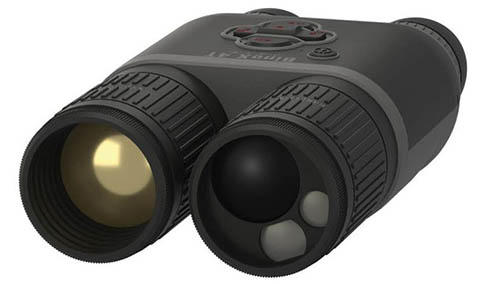
| Magnification: | 2.5–25x |
| Resolution: | 640×480 |
| Battery life: | 16 hours |
| Weight: | 2.5 pounds |
If you’re looking for the best overall thermal binoculars, you don’t need to look any further than the ATN BinoX-4T 640. They’re an outstanding mix of price and performance and have an exceptional magnification range. It starts at 2.5x, which lets you view close targets, but you can expand it to 25x for things that are far away. Next, the resolution is about as good as it gets. Paired with the built-in IR illuminator, the laser rangefinder, and the Wi-Fi streaming capabilities, there’s not much that these thermal binoculars can’t do.
While all those things are impressive on their own, one of the most remarkable features is the 16-hour battery life. These thermal binoculars will work whenever you need them.
- Outstanding mix of price and performance
- Phenomenal magnification range
- Great battery life
- Built-in IR illuminator
- Includes Wi-Fi streaming
- Includes laser rangefinder
- Slightly expensive
2. FLIR Systems Scout III 320 — Best Value
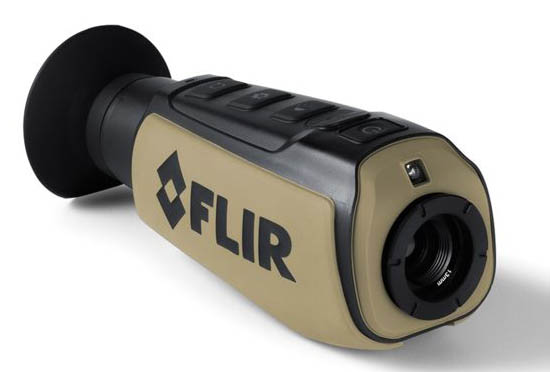
| Magnification: | 2x |
| Resolution: | 320×240 |
| Battery life: | 5 hours |
| Weight: | 12 ounces |
While there’s no such thing as high-end low-cost thermal binoculars or monoculars, the FLIR Systems Scout III 320 costs less than the other options on this list and still does a great job. It’s easily the best thermal monocular for the money.
It’s incredibly lightweight and portable, and with a 600-yard detection range, it does a great job of picking up thermal heat signatures even at long distances. The resolution isn’t quite as high as the more expensive options, but it’s still clear enough to make out most things.
The problem is the fact that there’s only one magnification range: 2x. While that’s great for many applications, it does limit what you can do with it. Finally, the 5-hour battery life lasts long enough for most things, but it’s still on the short end of things.
- Affordable
- Lightweight
- Up to 600-yard detection
- No eye relief and true “field of view”
- Low resolution
- Only one magnification range
- Short battery life
- Not binoculars
3. Newcon Optik Sentinel MLRF — Premium Choice
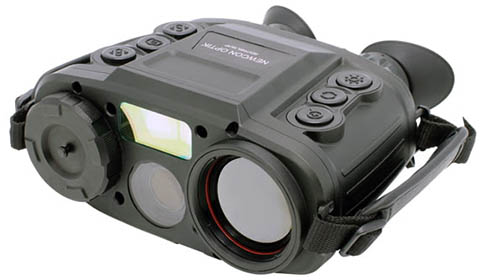
| Magnification: | 1–8x |
| Resolution: | 640×512 |
| Battery life: | 5 hours |
| Weight: | 3.3 pounds |
There are expensive thermal binoculars, and then there’s the Newcon Optik Sentinel MLRF. While these thermal binoculars are by far the most expensive option on this list, they’re also the best. They give you phenomenal resolution, and you can’t beat the magnification range.
Not only do they have a true 1x magnification, but you can also get up to an 8x optical zoom. These thermal binoculars work in any conditions, and it’s easy to export data to peripheral devices.
But while all those features are nice, what really sets these thermal binoculars apart — and drives up the price — is the laser rangefinder and the features that it includes. It instantly measures the distance, azimuth, and inclination of a target.
These are expensive, but they also give you far more than what you can expect from any other thermal binoculars on the market.
- Outstanding resolution
- Works in any conditions
- Easy to export data to peripheral devices
- Phenomenal magnification range
- Includes laser rangefinder
- Instantly measures distance, azimuth, and inclination of target
- Expensive
4. ATN BinoX-4T 384
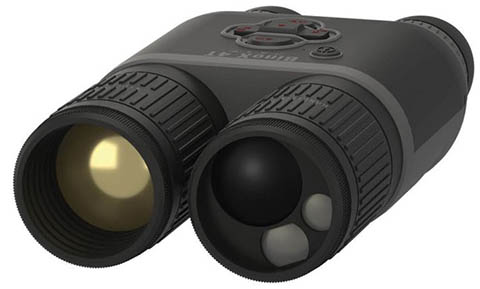
| Magnification: | 4.5–18x |
| Resolution: | 384×288 |
| Battery life: | 16 hours |
| Weight: | 2.5 pounds |
The ATN BinoX-4T 384 is extremely similar to the BinoX-4T 640, but the truth is that it’s a downgraded option. It’s not quite as expensive, but it also doesn’t have the same specifications.
The magnification range is smaller but still impressive, and the resolution isn’t quite as sharp. Still, it has plenty of features, including a laser rangefinder, video recording, and a built-in IR illuminator. Additionally, the battery life of 16 hours is more than enough to handle just about any trip.
Even with all these great features, this model is beat out by the BinoX-4T 640. Still, this is a low-priced option, so if you don’t need the extended magnification range and higher resolution, you can save yourself money by going with the lower quality and lower-priced BinoX-4T 384.
- Affordable
- Great magnification range
- Includes laser rangefinder
- Video recording
- Outstanding battery life
- Built-in IR illuminator
- Low resolution
5. AGM Global Vision Explorator
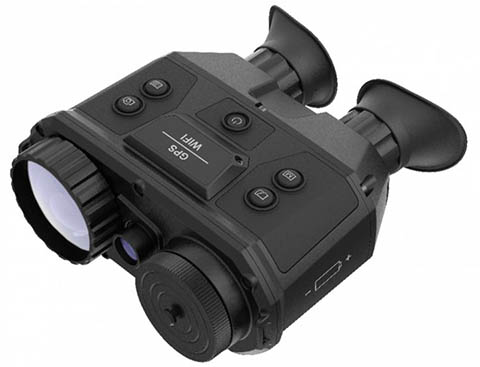
| Magnification: | 4x |
| Resolution: | 640×480 |
| Battery life: | 7 hours |
| Weight: | 2.2 pounds |
The AGM Global Vision Explorator is a great thermal binocular choice. There’s only one magnification range here, and at 4x, it’s not the most versatile, but the resolution that you get is top-notch.
It’s a lightweight option that you can easily mount to a tripod to record in different situations. Whether you’re holding it up to your eyes to see what’s going on or recording a location and streaming the data somewhere else, this thermal binocular can do it all.
It’s also completely waterproof, so you don’t need to worry about leaving it out on a tripod when it starts to rain. Still, there is only one magnification range, and this is an expensive product.
- Outstanding resolution
- Completely waterproof
- Easy to mount and use
- Lightweight
- Expensive
- Only one magnification range
6. Burris BTH 50
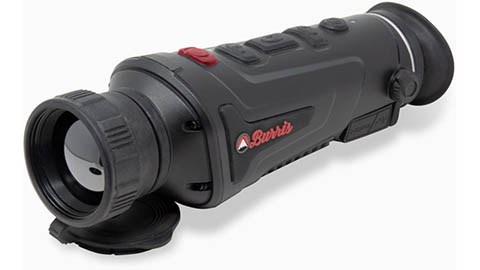
| Magnification: | 3.3–13.2x |
| Resolution: | 400×300 |
| Battery life: | 5 hours |
| Weight: | 1.2 pounds |
If you’re looking for a monocular or simply don’t want to spend the extra money for binoculars, the Burris BTH 50 is definitely something that you want to check out. For a thermal-imaging device, it’s an affordably priced option, and it comes with an outstanding magnification range.
It’s also extremely light and has decent resolution. It comes with tons of technological features, like adjustable contrast and brightness, and it works great with different apps. All this translates to a quality device at an affordable price.
The tradeoff is that it is a monocular, which can make it more challenging for you to narrow down targets, and it has a short battery life. 5 hours is long enough for most outings, but it’s on the short end of things.
- Affordably priced
- Phenomenal magnification range
- Lightweight
- Works with various apps
- Adjustable brightness and contrast
- Easy to use and portable
- Short battery life
- Monocular design
7. Pulsar Accolade 2 LRF XP50
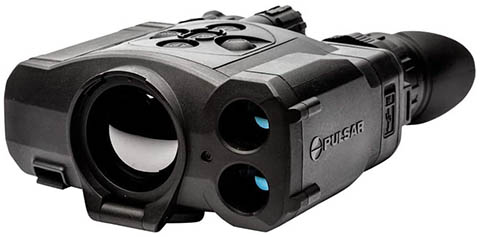
| Magnification: | 2.5 — 20x |
| Resolution: | 640×480 |
| Battery life: | 7 hours |
| Weight: | 1.5 pounds |
With one of the best magnification ranges and outstanding resolution, the Pulsar Accolade 2 LRF XP50 is a great product. While the 7-hour battery life isn’t the longest, it’s far from the shortest.
These thermal binoculars have built-in Wi-Fi, a picture-in-picture mode, and a built-in precision rangefinder too. It’s everything that you could want in thermal binoculars and more, but the tradeoff is the price.
They’re quite expensive, but if you can afford them, you’ll love every moment that you use them.
- Great resolution
- Phenomenal magnification range
- Wi-Fi integrated
- Picture-in-picture mode
- Waterproof design
- Built-in precision rangefinder
- Expensive
8. AGM Global Vision Explorator Pro
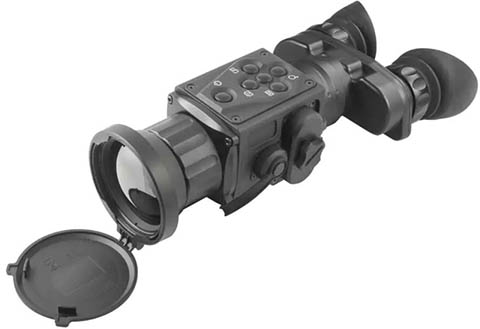
| Magnification: | 1x |
| Resolution: | 384×288 |
| Battery life: | 4.5 hours |
| Weight: | 1.8 pounds |
The AGM Global Vision Explorator Pro is essentially the monocular version of the Global Vision Explorator. It is a more affordable option for a thermal-imaging device, and that shows up in its features.
First, it only has a 1x optical magnification. The 2x, 4x, and 8x digital zoom only makes the image bigger, and resolution suffers as a result. While the resolution at 1x isn’t the worst, it’s not the best either.
This device also has the shortest battery life of any thermal-imaging product on this list at only 4.5 hours. But it does have Wi-Fi data transmission, which you may not even need it right away because it has 16 GB of built-in memory.
Finally, you can record videos and pictures with this monocular, making it a great tool to show off different events to your friends and family when you get back home!
- Affordably priced
- Built-in 16 GB memory
- Wi-Fi data transmission
- Includes 2x, 4x, and 8x digital zoom
- Video and picture records
- No optical magnification
- Short battery life
- Heavy for a monocular
9. Pulsar Helion 2 XP50

| Magnification: | 2.5x |
| Resolution: | 640×480 |
| Battery life: | 10 hours |
| Weight: | 1.1 pounds |
If you want a top-end quality monocular, the Pulsar Helion 2 XP50 is definitely worth considering. Just keep in mind that while it’s a monocular, it’s almost priced like binoculars. Basically, it’s expensive, but when you look at what it offers, it makes perfect sense.
First, the resolution is among the best in the industry. Second, the 10-hour battery life is double what many other devices offer. Third, this thermal monocular can pick up heat signatures from 2,000 yards out, which is also among the best in the industry.
Furthermore, it’s lightweight and waterproof for easy transportation and use. Finally, it all has all the technological gizmos that make it easy to use and share data. It’s Wi-Fi enabled and works great with the Stream Vision app.
However, it is expensive and there’s only one magnification range. So, while it does a great job, the overall applications of this thermal-imaging monocular are somewhat limited.
- High resolution
- Decent battery life
- Lightweight
- Waterproof design
- Heat-signature detection up to 2,000 yards
- Wi-Fi and Stream Vision app enabled
- Expensive for a monocular
- Only one magnification setting
10. Zeiss DTI Thermal Imaging Camera
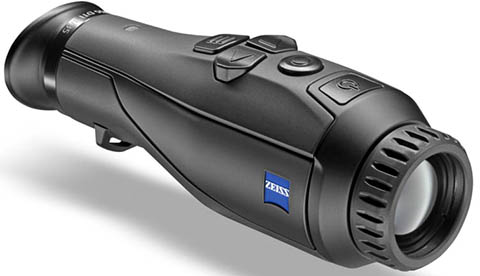
| Magnification: | 2.5x |
| Resolution: | 384×288 |
| Battery life: | 7 hours |
| Weight: | 1 pound |
The Zeiss DTI Thermal Imaging Camera is a tried-and-true recording thermal-imaging device, and if you like what the Zeiss Hunting App has to offer, it can integrate everything perfectly for you.
It’s extremely easy to use, and while it doesn’t have any optical zoom capabilities, you can digitally zoom in 0.5x increments to see exactly what you want at any given time. However, while it does a great job of recording and is easy to use, there are a few significant drawbacks.
First, it’s a bit too expensive for what you get. It’s lower priced than most thermal binoculars, but it’s expensive for a monocular. Second, the overall resolution is a bit low, especially considering how much you’re spending.
Finally, there’s only one magnification setting, and it’s an inconvenient 2.5x. While that’s a decent number to see semi-distant objects, it puts you between a rock and a hard place in many other situations, making it a bit more challenging to gauge distances.
- Includes digital zoom capabilities
- Easy to use
- Records what you see
- Compatible with ZEISS Hunting App
- Lightweight
- Expensive for a monocular
- Low resolution
- Only one magnification setting

Buyer’s Guide: How to Select the Best Thermal Binoculars (and Monoculars)
We developed this comprehensive buyer’s guide to answer any questions that you might have about thermal binoculars and monoculars.
From their different advantages to what those resolution numbers mean, we covered it all for you here.
Monoculars vs. Binoculars
One of the most important decisions that you need to make when picking out a thermal-imaging device is whether you want a monocular or binoculars. Obviously, one has one lens while the other has two, but what does that mean for you?
A monocular has a few advantages. First, it’s lightweight and easier to deploy and put away. If you plan on constantly switching back and forth, a monocular offers a clear advantage here.
Second, a monocular only has one lens, making it a bit more affordable for the manufacturer to produce. They pass these savings off to you, which means you can often get a good-quality monocular for a lower price than a pair of good-quality binoculars.
However, thermal binoculars have advantages of their own. First, they don’t cause eye fatigue the same way that a monocular does. Second, binoculars make it easy to scan a large area in a short amount of time. When you’re trying to track down something quickly, that’s a huge advantage. Finally, binoculars give you a much wider field of view, so you can see more at one time. Whether you’re hunting or in a tactical setting, this can make a significant difference.
What Do Those Resolution Numbers Mean?
Resolution differences all come down to the crispness of the image. You’ll be able to see what’s going on regardless, but you won’t get the same sharp edges with a 384×288 resolution as you would with a 640×480 resolution. But if you’re trying to determine if something is a deer or a person, either will work just fine.
Keep in mind that if you’re zooming in with a digital zoom, you’re cutting down on those resolution numbers. In fact, zooming doesn’t provide any real clarity. All it does is select the pixels in the middle and stretch them out to the zoom that you want. The quality of the image does not increase.

Optical vs. Digital Zoom
When you’re looking at certain products, you may notice that it states 1x magnification and a digital zoom. There’s a reason that this isn’t considered “true” magnification.
Products with an optical zoom provide the same quality resolution at the higher magnification levels. However, if a product only has digital zoom, when you zoom in, you’ll be sacrificing resolution. While it can make it easier to see objects in the field when you zoom digitally, you’re going to get a blurrier image than if you zoomed in with an optical zoom.
In short, optical zoom is always better than a digital zoom, but a digital zoom doesn’t cost as much to put into a device.
The Advantage of Wi-Fi Compatibility
If you want to do anything with the images and pictures that you capture on the field, one of the easiest ways is with a thermal-imaging device that offers Wi-Fi compatibility. Typically, all you’ll need is an app or program on your smartphone or computer, and the device will automatically send what it’s seeing.
You can store this information in the cloud, or you can put it on a local hard drive. Either way, you can pick and choose what you want to share.
If you want to share your images and videos, Wi-Fi compatibility is a feature that you want. You won’t have to worry about running out of local storage on your device and not being able to share the most exciting moments!

Conclusion
If you’re still debating about what thermal binoculars or monocular you need after reading through the reviews and the buyer’s guide, just know that there’s a reason that the ATN BinoX-4T 640 is our top choice, as it offers everything that you could possibly want in thermal binoculars.
However, if you are on a tight budget, the FLIR Systems Scout III 320 is a great introductory device that does more than enough for most situations. So, don’t wait and wish you had a thermal-imaging device the next time you’re out — order one of these top-notch products sooner rather than later.
Table of Contents
- A Glance at Our Top Picks (2024 Update)
- The 10 Best Thermal Binoculars (and Monoculars)
- 1. ATN BinoX-4T 640 — Best Overall
- 2. FLIR Systems Scout III 320 — Best Value
- 3. Newcon Optik Sentinel MLRF — Premium Choice
- 4. ATN BinoX-4T 384
- 5. AGM Global Vision Explorator
- 6. Burris BTH 50
- 7. Pulsar Accolade 2 LRF XP50
- 8. AGM Global Vision Explorator Pro
- 9. Pulsar Helion 2 XP50
- 10. Zeiss DTI Thermal Imaging Camera
- Buyer’s Guide: How to Select the Best Thermal Binoculars (and Monoculars)
- Conclusion
About the Author Robert Sparks
Robert’s obsession with all things optical started early in life, when his optician father would bring home prototypes for Robert to play with. Nowadays, Robert is dedicated to helping others find the right optics for their needs. His hobbies include astronomy, astrophysics, and model building. Originally from Newark, NJ, he resides in Santa Fe, New Mexico, where the nighttime skies are filled with glittering stars.
Related Articles:
When Were Binoculars Invented? History, Today & Future
How to Choose Binoculars for Bird Watching: 10 Expert Tips
How to Clean a Refractor Telescope: Step-by-Step Guide
How to Clean a Telescope Eyepiece: Step-by-Step Guide
How to Clean a Rifle Scope: 8 Expert Tips
Monocular vs Telescope: Differences Explained (With Pictures)
What Is a Monocular Used For? 8 Common Functions
How to Clean a Telescope Mirror: 8 Expert Tips



